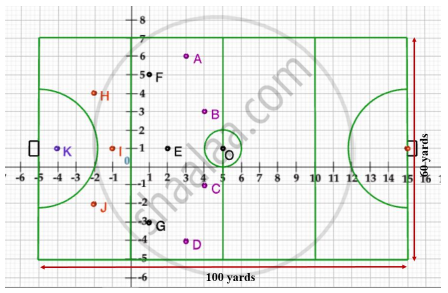Advertisements
Advertisements
Question
What is the distance of the point (– 5, 4) from the origin?
Options
3 units
`sqrt(14)` units
`sqrt(31)` units
`sqrt(41)` units
Solution
`sqrt(41)` units
Explanation:
Given points are (– 5, 4) and (0, 0).
Distance = `sqrt((x_2 - x_1)^2 + (y_2 - y_1)^2`
Here, x1 = – 5, y1 = 4, x2 = 0, y2 = 0
∴ Distance = `sqrt((0 - (- 5))^2 + (0 - 4)^2`
= `sqrt(5^2 + 4^2)`
= `sqrt(25 + 16)`
= `sqrt(41)`
Thus, the distance is `sqrt(41)` units.
APPEARS IN
RELATED QUESTIONS
If the point A(0, 2) is equidistant from the points B(3, p) and C(p, 5), find p. Also, find the length of AB.
Two opposite vertices of a square are (-1, 2) and (3, 2). Find the coordinates of other two
vertices.
Find all possible values of x for which the distance between the points
A(x,-1) and B(5,3) is 5 units.
Find all possible values of y for which distance between the points is 10 units.
Find x if distance between points L(x, 7) and M(1, 15) is 10.
Find the distances between the following point.
A(a, 0), B(0, a)
Find the value of a if the distance between the points (5 , a) and (1 , 5) is 5 units .
P and Q are two points lying on the x - axis and the y-axis respectively . Find the coordinates of P and Q if the difference between the abscissa of P and the ordinates of Q is 1 and PQ is 5 units.
x (1,2),Y (3, -4) and z (5,-6) are the vertices of a triangle . Find the circumcentre and the circumradius of the triangle.
Prove that the points (6 , -1) , (5 , 8) and (1 , 3) are the vertices of an isosceles triangle.
Prove that the points (4 , 6) , (- 1 , 5) , (- 2, 0) and (3 , 1) are the vertices of a rhombus.
From the given number line, find d(A, B):

A point A is at a distance of `sqrt(10)` unit from the point (4, 3). Find the co-ordinates of point A, if its ordinate is twice its abscissa.
Points A (-3, -2), B (-6, a), C (-3, -4) and D (0, -1) are the vertices of quadrilateral ABCD; find a if 'a' is negative and AB = CD.
Find distance of point A(6, 8) from origin
A circle drawn with origin as the centre passes through `(13/2, 0)`. The point which does not lie in the interior of the circle is ______.
Case Study -2
A hockey field is the playing surface for the game of hockey. Historically, the game was played on natural turf (grass) but nowadays it is predominantly played on an artificial turf.
It is rectangular in shape - 100 yards by 60 yards. Goals consist of two upright posts placed equidistant from the centre of the backline, joined at the top by a horizontal crossbar. The inner edges of the posts must be 3.66 metres (4 yards) apart, and the lower edge of the crossbar must be 2.14 metres (7 feet) above the ground.
Each team plays with 11 players on the field during the game including the goalie. Positions you might play include -
- Forward: As shown by players A, B, C and D.
- Midfielders: As shown by players E, F and G.
- Fullbacks: As shown by players H, I and J.
- Goalie: As shown by player K.
Using the picture of a hockey field below, answer the questions that follow:

The coordinates of the centroid of ΔEHJ are ______.
Points A(4, 3), B(6, 4), C(5, –6) and D(–3, 5) are the vertices of a parallelogram.
Ayush starts walking from his house to office. Instead of going to the office directly, he goes to a bank first, from there to his daughter’s school and then reaches the office. What is the extra distance travelled by Ayush in reaching his office? (Assume that all distances covered are in straight lines). If the house is situated at (2, 4), bank at (5, 8), school at (13, 14) and office at (13, 26) and coordinates are in km.
